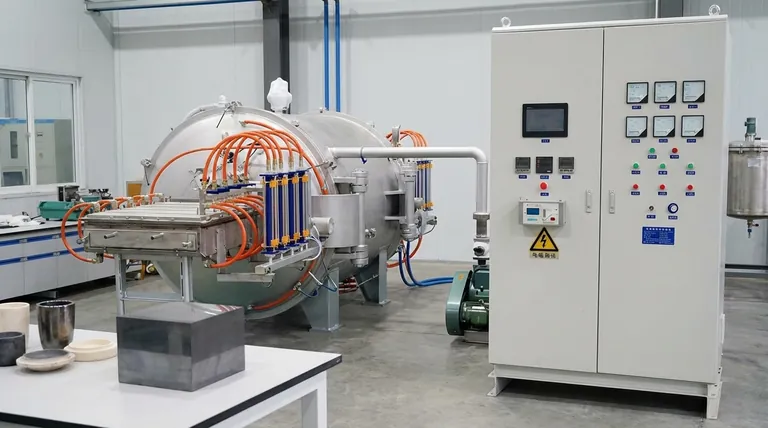At its core, graphite is a material of dualities. It is mechanically robust, extremely rigid, and maintains its shape under significant stress, making it a powerful choice for structural applications. However, this rigidity comes with a critical trade-off: it is also brittle and can be prone to chipping or fracture from sharp impacts.
Graphite's value lies in its exceptional rigidity and dimensional stability, allowing for robust and efficient designs. The primary challenge for any engineer is to design around its inherent brittleness to prevent failure from impact or shock loading.

The Foundation: Rigidity and Dimensional Stability
Graphite's atomic structure gives it a unique combination of properties. Its rigidity is fundamental to its performance in demanding industrial environments, such as furnace components.
Exceptional Rigidity
Graphite is very rigid, meaning it resists bending and deformation when a load is applied. A component like a furnace hearth made from graphite will not sag or change shape under heavy loads.
Long-Term Shape Retention
This rigidity extends over time. Graphite components can maintain their precise shape almost indefinitely, showing very little creep or distortion even after prolonged use at high temperatures.
The Benefit: High Mechanical Robustness
This inherent strength and stability translate directly into significant design and operational advantages. Engineers leverage graphite's robustness to create more efficient and productive systems.
Enabling Efficient Design
Because graphite is so strong, designs can often be made smaller and with less complexity. Fewer fixture support systems are needed, simplifying the overall engineering and reducing material costs.
Supporting Larger Capacities
The ability to use smaller, stronger components allows for more efficient use of space. In a manufacturing context, this directly leads to the ability to process larger batch sizes, increasing throughput and productivity.
Understanding the Trade-offs: Brittleness
The most critical factor to consider when working with graphite is its lack of ductility. While it is very strong, it is not tough.
The Key Limitation: Brittleness
Graphite's primary mechanical weakness is its brittleness. Unlike metals, which will bend or deform before breaking, graphite tends to fracture suddenly when its elastic limit is exceeded.
Susceptibility to Impact
This brittleness makes graphite components, such as hearth rails, prone to chipping or cracking during the handling or transfer of loads. A sharp impact can cause a catastrophic failure that a more ductile material would easily absorb.
Making the Right Choice for Your Application
Successfully implementing graphite requires a clear understanding of its strengths and weaknesses in the context of your specific goal.
- If your primary focus is structural integrity and stability: Graphite's rigidity and long-term shape retention make it an excellent choice for fixtures, hearths, and other components that must not deform under load.
- If your primary focus is high-throughput and efficiency: Leverage graphite's robustness to create smaller, simpler designs that allow for larger batch sizes and increased productivity.
- If your application involves potential impact or shock: You must design protections to account for graphite's brittleness, as it will not withstand sharp blows without chipping or fracturing.
Understanding this balance between immense rigidity and inherent brittleness is the key to unlocking graphite's full potential in your designs.
Summary Table:
| Property | Characteristic | Key Consideration |
|---|---|---|
| Rigidity | Extremely high, resists bending and deformation. | Enables robust, simple designs with less support. |
| Dimensional Stability | Excellent long-term shape retention, even at high temperatures. | Ideal for fixtures and components requiring precision. |
| Strength | High mechanical robustness under load. | Allows for smaller components and larger processing capacities. |
| Brittleness | Low fracture toughness, prone to chipping from impact. | Requires careful handling and design to prevent shock failure. |
Optimize Your High-Temperature Processes with the Right Materials
Understanding the precise mechanical properties of graphite is crucial for designing efficient and reliable high-temperature systems. The balance between its exceptional rigidity and inherent brittleness must be carefully managed for success.
KINTEK specializes in high-performance lab equipment and consumables, including premium graphite components for demanding applications. We provide the materials expertise and reliable products to help you:
- Design for Stability: Leverage graphite's rigidity for fixtures, hearths, and supports that won't sag or deform.
- Maximize Throughput: Utilize its strength to build efficient systems with larger capacities.
- Mitigate Risk: Get expert guidance on handling and design to protect against brittle failure.
Let's discuss how the right graphite solutions can enhance your laboratory's efficiency and productivity. Contact our experts today for a consultation!
Visual Guide

Related Products
- Graphite Vacuum Continuous Graphitization Furnace
- Ultra-High Temperature Graphite Vacuum Graphitization Furnace
- Vertical High Temperature Graphite Vacuum Graphitization Furnace
- Graphite Vacuum Furnace High Thermal Conductivity Film Graphitization Furnace
- Graphite Vacuum Furnace IGBT Experimental Graphitization Furnace
People Also Ask
- What is the maximum working temperature of graphite? Unlock High-Temp Performance with the Right Atmosphere
- How is synthetic graphite manufactured? A Deep Dive into the High-Temperature Process
- Is graphite affected by heat? Discover Its Remarkable Strength and Stability at High Temperatures
- What happens to graphite at high temperatures? Unlock its Extreme Heat Resistance
- Why can graphite withstand heat? Unlocking Its Extreme Thermal Stability for Your Lab



















